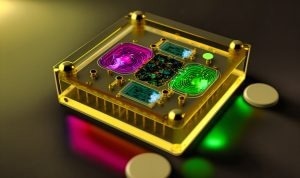Integrated circuits (ICs) are an integral part of modern technology, and they can be found in a wide array of devices, from smartphones and computers to medical diagnostic tools. However, conventional electronic ICs are limited in bandwidth, speed, and energy efficiency as they depend on electrons. To overcome these limitations and trigger a new wave of enhanced performance, researchers and engineers are turning to Photonic Integrated Circuits (PICs), taking advantage of the speed and efficiency of photons over electrons.
Understanding Photonic Integrated Circuits
- Transitioning from Electronics to Photonics: PICs use photons for faster and more efficient data processing, whereas conventional ICs transmit data using electrons. By leveraging the benefits of light, such as minimal interference and high-speed transmission, PICs mark a paradigm shift in integrated circuit technology.
- Components and Functionality: Traditional optical ICs are comprised of laser diodes, waveguides, filters, and gain media, all affixed to a flat substrate, typically a silicon wafer. Waveguides, acting as the optical equivalent of metallic wires, exploit light through several principles, including total internal reflection. This arrangement minimizes energy loss by enabling high-speed transmission, which makes PICs exceptionally powerful and efficient.
- Challenges and Progress: While PICs exhibit huge potential, they remain in the developmental stage, with increased costs and limited availability. Traditional ICs are much easier to access and are widely available. Furthermore, PICs take up more space, albeit still on a micron scale. However, continued advancements and the integration of micro-optics are accelerating the miniaturization of PICs, providing an opportunity for compact, lightweight systems with greater accessibility.
Applications of Optical ICs
- Communication: PICs play a central role in optical communications, offering improved reliability and transmission capacity compared to conventional ICs, especially in fiber and free-space optical communication systems.
- Optical Metrology: Fields such as LIDAR and fiber-optical sensors take advantage of the precision and sensitivity PICs provide, facilitating advancements in measurement and detection technologies.
- Quantum Computing: PICs' novel properties make them good candidates for quantum computing and cryptography. This could lead to potential breakthroughs in secure communication and computational power.
- Biosensing: Photonic-integrated chip biosensors have revolutionary potential in medical diagnostics as they enable rapid, label-free testing with unparalleled sensitivity. These sensors, typically based on silicon nitride substrates, pick up minute changes in refractive index, offering real-time, reliable results key for healthcare applications.

Optical IC-based lab-on-a-chip biosensors deliver crucial real-time and reliable results essential for medical diagnostics. Image Credit: Shanghai Optics
As continued research and development in the field of photonic integrated circuits helps bring about new advancements, the groundbreaking potential of these technologies becomes increasingly evident. From changing the game in telecommunications to facilitating state-of-the-art biosensing applications, PICs take up a central role in future innovation, positioned to transform diverse industries and improve the way we interact with technology.

This information has been sourced, reviewed and adapted from materials provided by Shanghai Optics.
For more information on this source, please visit Shanghai Optics.